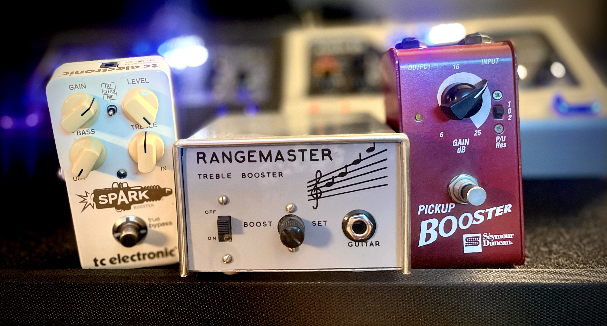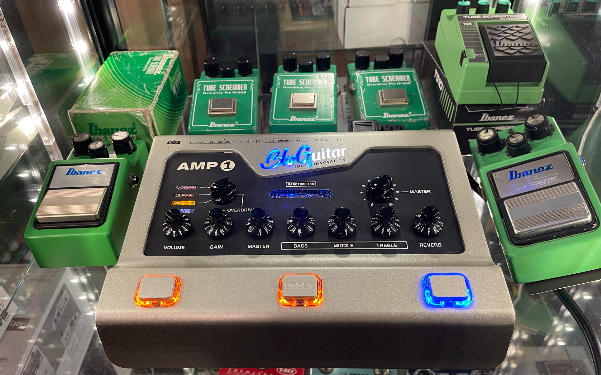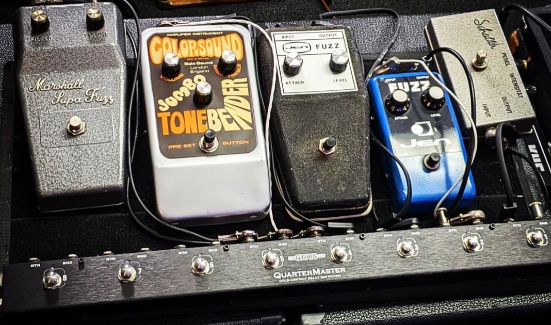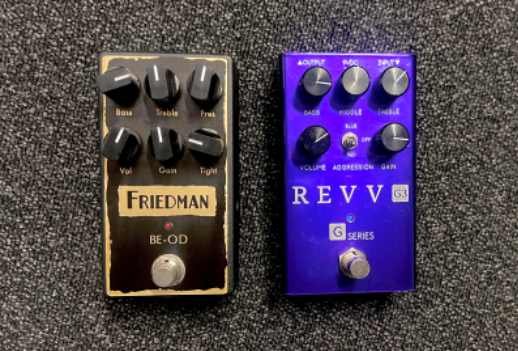Difference between Booster, Overdrive, Distortion and Fuzz
What is the difference between booster, overdrive, distortion and fuzz pedals?
Booster, overdrive, distortion and fuzz pedals produce different types of distortion effects for guitars, they have different functions and tonal characteristics.
Booster
-
Signal boost: A booster increases the volume of the signal, allowing you to make your sound louder without compromising the sound quality. This can be useful for standing out when soloing or for increasing the overall volume of your guitar in a song.
-
Gain increase: Some boosters also offer the option to increase the gain or distortion of the signal. This can help make the sound thicker or more aggressive, especially when the booster pedal is used in front of an overdrive or cranked-up tube amp.
- Sound shaping: Even though the booster pedal's primary purpose is to amplify the signal, some booster pedals can also be used to shape the sound. For example, some boosters offer EQ controls that allow you to adjust the treble, midrange and bass.

Conclusion: Boosters are versatile effects pedals that can be used in a variety of ways. They are often used by guitarists to emphasize their sound during a guitar solo, to boost the tone of a tube amp, or to drive other effects pedals. A booster can also help improve the dynamics of a guitarist's playing and create a wider range of tonal possibilities.
Overdrive
-
Distortion: An overdrive overdrives the guitar's input signal by adding additional harmonic overtones. This results in a pleasant, dynamic and musical distortion effect that naturally enhances the guitar's tone.
-
Dynamics: Overdrives react to the guitarist's attack behavior. Depending on how hard or softly you hit the strings, the intensity of the distortion changes. This allows for a differentiated playing style and good dynamic control.
- Timbre: Overdrives can shape the tone of the guitar in subtle ways. Many overdrive pedals offer EQ controls that allow you to adjust the highs, mids and bass to sculpt and customize a sound.

Overdrives are popular in various music genres, including rock, blues, country, and pop. They are often used to simulate the sound of tube amps, to create a warm and dynamic distortion, or to emphasize the tone during solos.
Distortion
-
Heavily distorted sound: A distortion heavily overdrives the guitar's input signal and adds a large amount of harmonic overtones, resulting in an extremely distorted sound. This aggressive sound is well suited to music genres such as metal, punk or hard rock.
-
Compression: Distortion pedals often also offer a certain amount of signal compression. This means that different playing intensities and attack strengths of the guitarist are balanced out, resulting in a more even volume level
-
Sustain: Distortion pedals can also help extend the sustain of a note. This allows you to play long, singing notes that last for a longer period of time.

Distortion pedals are popular with hard'n'heavy guitarists looking for extreme and distorted sounds. They are often used to play hard riffs, accentuate aggressive solos, or to create a generally loud and overwhelming wall of sound.
In summary, a distortion pedal produces a very strong, alienated and aggressive distortion that extremely influences the sound of the guitar and gives additional intensity to the playing.
Fuzz
-
Extreme Distortion: A fuzz overdrives the guitar's input signal in a very extreme way by adding massive amounts of harmonic overtones. This results in a buzzy, crunchy and highly distorted sound that is often described as "fuzzy".
-
Sustain and compression: Fuzz pedals are known for their ability to extend the sustain of notes and compress the signal, creating a rich and singing tone that is especially popular for solos and loud riffs.
- Sound character: Fuzz pedals often have a characteristic sound that guitarists find particularly unique and distinctive. This "fuzzy" sound can vary depending on the pedal manufacturer and model, but overall a fuzz effect is characterized by its aggressive and idiosyncratic character.

Fuzz pedals became popular in the 1960s, especially in rock music. Famous guitarists such as Jimi Hendrix have used fuzz pedals to create their own personally distinctive guitar sound. Today, the fuzz pedal is used in various genres of music, including rock, blues, psychedelic, stoner rock, and even experimental music styles.
In summary, a fuzz effect pedal generates an extremely distorted, compressed and humming sound coloration that produces a characteristic and distinctive sound with high intensity.
For several years, manufacturers such as Soldano, Friedman, Revv etc. have also been offering their signature sounds of the distorted preamp channels in pedal form These pedals, known as “amp in a box”, work with several cascaded gain stages. To ensure the best possible sound, they should be connected in front of a clean amplifier or directly into the effects return.

The AMP1 Mercury Edition and the Iridium Edition harmonize perfectly with all types of these pedals. Both amplifiers offer a flexible and versatile sound palette that allows you to seamlessly integrate effects and achieve a first-class sound. The AMP1 reproduces the characteristics of the pedals excellently, especially in the clean and vintage channels.